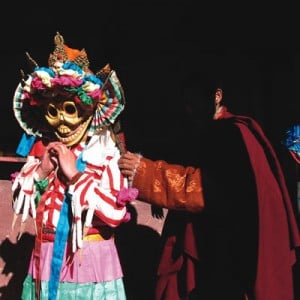
“A Cham (ritual monastic) dancer at a monastery in Kardze (Chinese: Ganzi), Sichuan (the Tibetan area of Kham) during a celebration of Tibetan Buddhist protector deities at the monastery in winter 2005. The deity depicted by this dancer, Mahakala, represents the cosmic nature of time.
In Tibet, the control and monitoring of religious institutions has been stepped up following the issuing of new regulations on religion which came into effect in the PRC on March 1 2005. Religious control also extends beyond Tibetan monasteries and nunneries to the wider society, and ICT has obtained a document from Tibet which details a ban on Tibetan prayer-flags in one area, saying that those who continue to display these traditional signs of religion devotion will face “serious penalties”.
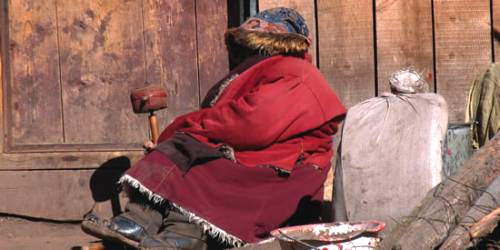
A Tibetan devotee rests at a monastery with prayer wheel.
The Regulations on Religious Affairs (originally passed by the Standing Committee of the State Council in July 2004) further systematize the rules restraining religious practice in China and Tibet, and strengthen the bureaucratic and legal mechanisms used to enforce those rules. As a result, religious institutions in Tibet are being undermined still further and a complete religious education is increasingly difficult if not impossible to obtain in Tibet.
Factors including the continual process of monitoring and political campaigns, the requirement of regular classes of patriotic education and political indoctrination, restricted numbers of monks and nuns, the lack of highly educated teachers and spiritual leaders, and the presence of a mainly adult population due to bans on under-age monks, means that increasingly monasteries in Tibet are unable to produce a core group of highly educated individuals.
In one area of Amdo (now part of Qinghai province), the local Religious Affairs Control Bureau announced that prayer-flags, one of the most widespread and traditional manifestations of religious devotion in Tibet, were forbidden. The document, issued in Gyurme township in Darlag (Chinese: Dari) county, Golog (Chinese: Guoluo) Tibetan Autonomous Prefecture, and dated June 1, 2004, was entitled “Public Announcement by the Religious Affairs Control Bureau concerning the Prohibition to Arbitrarily Display ‘Wind horse’ Prayer flags, Flagstaffs and the Use of Religious Scripts near Tibetan Fortresses [buildings]1”. The document states that “The arbitrary display of prayer flags and prayer flagstaffs on Party and Government buildings, and on mountain tops near fortresses and the use of religious scripts2 must be abolished.” Prayer-flags (lung-ta, or wind-horses) are inscribed with religious prayers or mantras traditionally displayed outside Tibetans’ homes, monasteries, mountain peaks and places of spiritual practice. According to centuries-old belief, the power of the blessing of the prayers printed on the material lies in the ability to be dispersed by the wind. The tradition of erecting flagstaffs and hanging prayer flags is common practice all over Tibet from the roof-tops of peoples’ homes to monasteries and mountain peaks, and it is one of the strongest and most visible elements of Tibetan religious identity. A full translation of the document follows below.
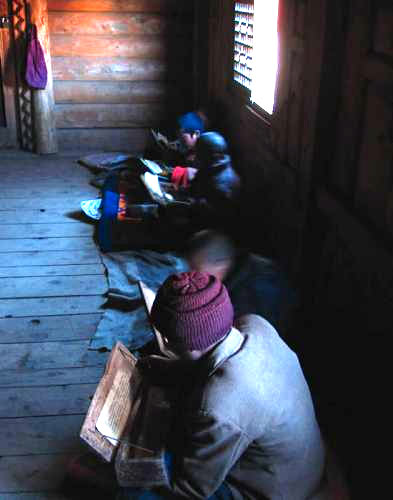
Children studying the Tibetan language at a monastery in Kham.
Since the Regulations on Religious Affairs were promulgated, they have been distributed to major religious institutions in Chinese and also translated into Tibetan. The bureaucracy strengthened by these new regulations consists mainly of the State Administration of Religious Affairs, a hierarchy of religious affairs bureaus in all administrative units such as provinces, townships and counties, and the Ministry of Public Security and local police units.
A Western Buddhist scholar who has traveled widely in Tibetan areas since the regulations were implemented told ICT: “It is my sense that many monasteries and other religious institutions feel under pressure to adhere to these regulations and requirements as a necessary step in the preservation of their activities, maintenance of their teaching lineage, and the very existence of their institutions. Although the registration required by the government allows the monastery or nunnery to continue to function, it also allows for more political scrutiny. Tibetan monks and nuns know that the registration opens up their institution to more intense monitoring and a series of official campaigns aimed at the indoctrination of religious professionals, monks or nuns.”
Ban on prayer-flags in Darlag
Visitors to Darlag in the past few months have confirmed that prayer flags are not visible in the area, and that a Chinese-run shop selling ‘wind-horses’ has been closed down. The warning, which was issued in 2004, was still visible pasted on walls.
Public Announcement by the Religious Affairs Management Office of Darlag concerning the Prevention to Arbitrary Erect Prayer Flags and Flagstaffs in the Proximity of Fortresses (Translation by ICT):
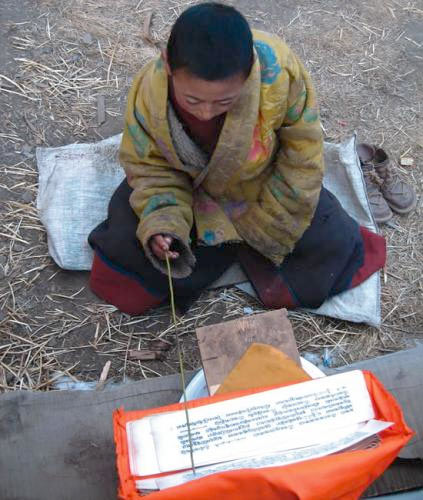
A young Tibetan monk studies religious texts.
In recent years, arbitrary erection of prayer flags (rlung rta) and flagstaffs (dar lcog), and the use of religious scripts (chos yig) on hilltops in the vicinity of fortresses and inside of household fences in our town have influenced the image of the Party and of the government. The warning displayed below has been issued to lead to a mutually harmonious relationship between religion and socialist society, to strengthen ethnic unity, to promote the construction of the ‘three represents’,3 and to intensify a concerned socialist construction.
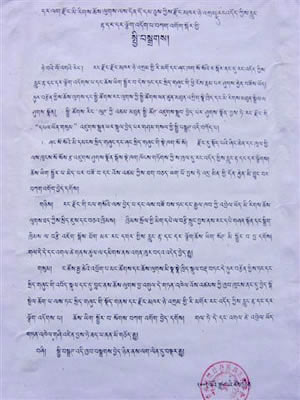
The official notice banning prayer-flags in Darlag.
- Each unit of People’s Government and County Government in each village and all the offices at provincial and district level residing in the county with various organizational and strengthening systems will abolish the arbitrary erection of prayer flags, flagstaffs and the use of religious scripts. Additionally, with appropriate decisions, they will prevent the recurrence of similar problems.
- All retired government officials and employees will set a good example and observe policies, laws, and regulations concerning popular religion in harmony with the Party and the country. Above all, by setting themselves as good examples and respecting the regulations, they will ensure that there will be no arbitrary use of prayer flags, flagstaffs, religious scripts. In the case they are exposed to wrong situations they are responsible for making enquiries.
- We, in response to the large community of nomads and various religious leaders, will diligently promise on behalf of the Party and the government that the diffusion of such religious activities is allowed under appropriate regulations. The arbitrary installation of prayer flags and flagstaffs on Party and government buildings and on mountain tops nearby fortresses, and the use of religious scripts must be abolished. If this and other wrong actions are carried out, serious penalties will be applied.
- This announcement will be effective from the day of its diffusion.
Bureau of Religious Affairs, Dari, Qinghai Province
June 1, 2004
You can find this report as a PDF document here »
1 This is likely to refer to all Tibetan traditional stone-and-mud houses in the town and ancient ‘protector deity’ shrines which can be found on mountain and hill-tops throughout Tibet
2 This is likely to be a reference to the small paper prayer flags that are thrown in the air on mountain tops and at mountain passes as part of traditional spiritual practice
3 The ‘Three Represents’ is a theory developed by the former President of China Jiang Zemin for the Communist Party in 2000, in an attempt to cement his historical legacy as a Marxist theorist on the level of Mao Zedong and Deng Xiaoping. It refers to what the Chinese Communist Party stands for, according to the Party – “the development trends of advanced productive forces; the orientations of an advanced culture, and the fundamental interests of the overwhelming majority of the people of China” (see Three Represents here). The ‘Three Represents’ apparently legitimizes the inclusion of capitalists and private entrepreneurs within the Communist Party, but many Chinese find it incomprehensible

